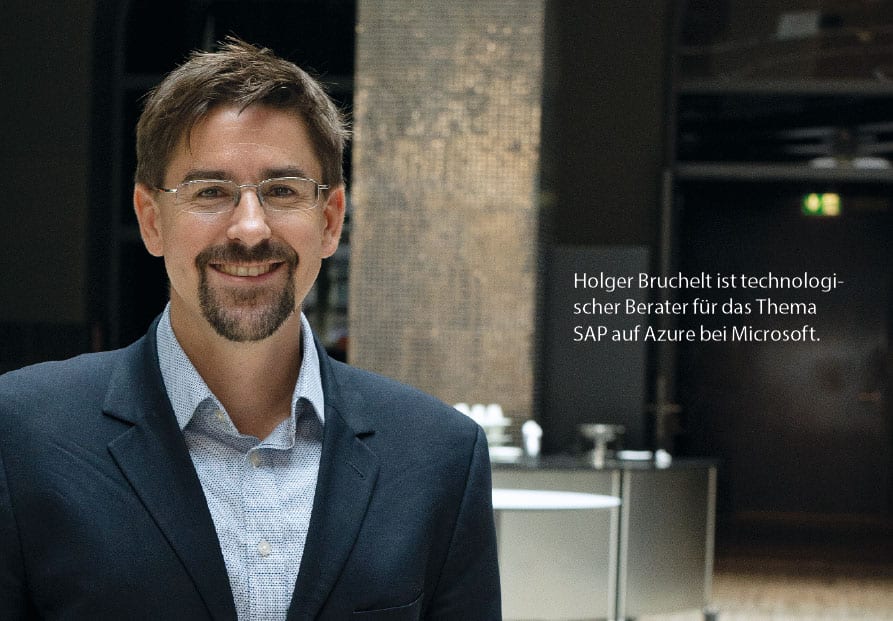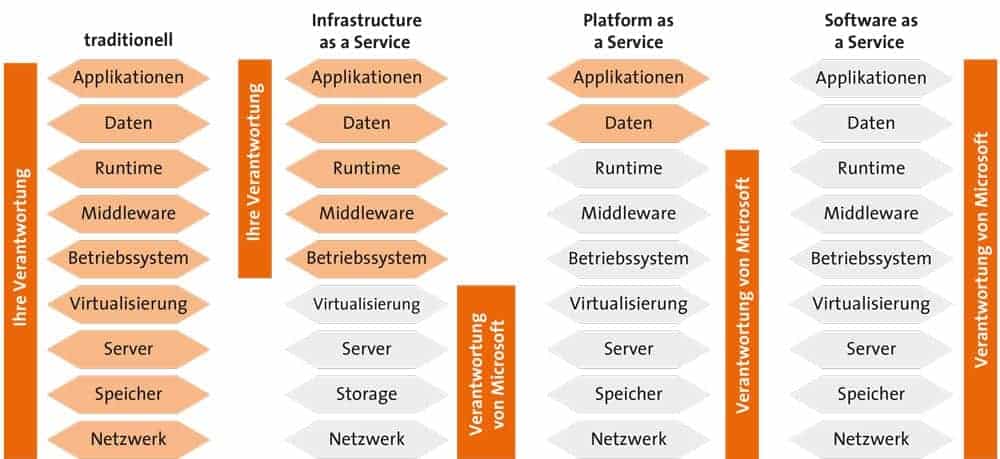A cloud for SAP
![[shutterstock.com: 578217358, ktsdesign]](https://e3mag.com/wp-content/uploads/2020/07/shutterstock_578217358.jpg)

The illustration on page 65 shows the different models for cloud operation. With the Software as a Service (SaaS) model, the user receives everything from a single source: infrastructure, application and operation are supplied directly by the manufacturer.
Like the SAP Cloud Platform, Azure is an example of the "Platform as a Service" (PaaS) model. Here, the infrastructure and runtime environment are also provided by the manufacturer, but customers have the option of developing their own applications on it.
Microsoft also plays a role in the Infrastructure as a Service (IaaS) sector. In IaaS scenarios, the manufacturer "only" provides the infrastructure.
In contrast to on-premises operation or classic hosting offers, however, IaaS encompasses much more. The scaling effects offer new possibilities and great flexibility and agility.
The cloud infrastructure for providing Microsoft Azure is spread across numerous data center regions around the world. Several of these regions are located in Europe, others in the USA and Asia. In total, there were over 60 of these regions in June 2020.
For companies in German-speaking countries, the most interesting regions are Germany West Central (location: Frankfurt), Germany North (Berlin), Switzerland West (Geneva), Switzerland North (Zurich) as well as West Europe (Amsterdam) and North Europe (Dublin).
A single Azure region consists of several data centers. These data centers are sometimes separated from each other by several kilometers within the region and each consists of thousands of servers.
To ensure reliability, the computers are distributed across different availability sets or availability zones. This allows you to divide up your installations so that different computers are located in different fire compartments and have different power or network supply lines.

Availability
Of course, Microsoft always has to fix errors in the infrastructure and apply new patches. Many of these patches can now be carried out online without affecting the virtual machine.
Operation simply continues. So that a cluster setup can continue to be operated even if the virtual machine is restarted, there are so-called fault domains in addition to the availability sets.
Installing different servers in these fault domains means that two virtual machines never have to be stopped at the same time if patching is necessary. This also ensures continuous operation.
All Azure regions are connected to each other with network cables. Unlike other cloud providers, this network belongs to Microsoft, so service level agreements (SLAs) or throughput rates can be handled very differently. You can therefore install your SAP system in Europe and give users in the USA access to this system via the Azure network.
Platform as a Service
Azure consists of numerous PaaS solutions that make it possible to use simple services such as scenarios for machine learning, artificial intelligence or the Internet of Things.
As with the SAP Cloud Platform, you can access and use these services without having to install on-premises software. This allows you to develop mobile applications very easily, for example, or extend web applications with new functionality.
In particular, a combination of functions offered by SAP (e.g. via the SAP Cloud Platform) and Microsoft (via Azure) can result in interesting and innovative solutions.
For example, one could imagine scenarios in which SAP Fiori Cloud solutions are developed via the SAP Web IDE on the SAP Cloud Platform, using functions such as authentication via the Azure Active Directory or image recognition via Azure Cognitive Services.
Infrastructure as a Service
In addition to these solutions, Azure also offers IaaS functions. IaaS makes it very easy to access virtual machines. This offers great flexibility and cost savings. This IaaS functionality is also very interesting in the SAP environment.
In the early years of Azure, these virtual machines were only used for sandbox or developer systems. Azure now offers the widest range of available machines - e.g. up to 20 TB for Hana systems - and has therefore also established itself for the productive use of SAP systems.
Many companies initially decide to simply run their SAP systems on virtual machines in the Azure cloud. This does not change anything for the basic administrator.
The only difference is that the SAP GUI now connects to a server in the Azure Cloud. Other companies also outsource the operation of the SAP landscape to a partner. The advantage for the customer is that they can easily switch partners without having to migrate the landscape.
This was not feasible with the classic hosting approach: A change of partner was usually only possible with a migration of the hosting data center and therefore relatively costly.
SAP customers can also obtain the Hana Enterprise Cloud on Azure. This allows them to outsource their SAP operations to SAP, for example, but still obtain other non-SAP applications from the same infrastructure (Azure).
Existing SAP customers can thus benefit not only from Azure's global presence, but also from shorter latency times, greater security and network advantages.

Test and sandbox systems
Sandbox, training and education systems from the SAP Cloud Appliance Library are an important area of application for the Azure infrastructure. Such a system can be set up within minutes and duplicated for the provision of multiple training systems.
SAP provides numerous preconfigured systems for this purpose via the Cloud Appliance Library. As part of the setup process, the SAP Cloud Appliance Library is given permission to create a virtual machine in the Azure Cloud and to start or stop it.
If the existing SAP customer wants to run more than just test or sandbox systems in a virtual machine on Azure, another aspect becomes important: SAP support.
It is not only necessary for SAP's Product Availability Matrix (PAM) to provide for the combination of operating system and database. The infrastructure must also be released and supported by SAP so that business-critical processes can be operated.
As with Windows Server and SQL Server, Microsoft is working very closely with SAP on this certification. The current list of approved virtual machines can be found in SAP Note 1928533. This list is constantly growing and already includes numerous virtual machines, from very small to very large.
Provision of hardware
In contrast to other cloud providers, Azure has a special feature: Microsoft not only offers fully flexible virtual machines, but also dedicated hardware. This means that customers can operate "small" machines with up to 12 TB of memory virtually, but can also go up to 20 TB of memory for larger Hana systems.
For most other database systems (AnyDB), the virtual machines of the so-called D and E series are sufficient. The E series starts with two virtual Central Processing Units (vCPU) and 16 GB RAM (the so-called E2v3) and goes up to 64 vCPUs and 432 GB RAM. The M series is interesting for Hana systems, among others. It starts at 192 GB RAM and goes up to 12 TB.
The big advantage of these virtual machines is that they can be used to the minute. This can be just as interesting for training systems as for peak loads.
In the SAP environment, the existing SAP customer can add further application servers to the landscape as required and thus achieve better load distribution. This is referred to as dynamic scaling.






